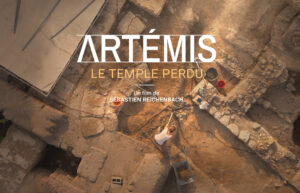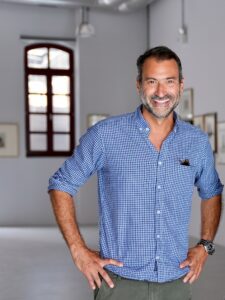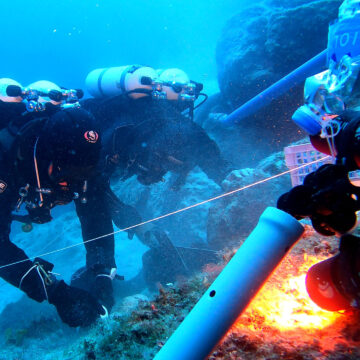Swiss Archaeology in Greece – News from the Field 2023
Director’s foreword
Like the end credits of a movie, the final scenes of the documentary Artemis – The Lost Temple feature the cast of characters who were involved in the rediscovery of the Amarynthos sanctuary. Aired on RTS and Arte (and soon to be translated into Italian and Modern Greek), this film marks a significant milestone in the history of research. And while the discovery of the Artemision seems obvious today, one should not forget that it remained a very distant prospect until the early 2000s.

Artemis – The Lost Temple (2023)
Today, the ESAG starts a new chapter in analyzing, publishing, and communicating the finds from the Artemision. Although conservation and study usually remain unknown to the public and rarely constitute the focus of a documentary, they are nonetheless critical and necessitate significant effort and resources. From a long-term perspective, the School’s mission at Amarynthos is only just beginning. We aim to establish a strong foundation in scientific research, logistics, and cultural heritage.
The project also faces significant challenges. The Eretria Museum has reached its maximum storage capacity and now requires an extension. The plans for this extension have already been submitted to the Ministry of Culture. Work is planned to begin in 2024 on a plot of land that was generously donated by the municipal council of Eretria. Significant resources must be invested in order to complete the extension: as in the past, the School relies on the generosity of private donors. Additionally, approximately 700 objects discovered in the temple must be restored and studied. The analysis of the discoveries and the architecture of the ancient temples will be featured in scientific monographs as part of the new Amarynthos Series. The first volume, scheduled to be released in 2024, is based on Denis Knoepfler’s study of a decree from the polis of Eretria concerning military officials and displayed in the sanctuary of Amarynthos.
Consequently, we shall pause fieldwork in the Artemision to set aside time for studying the material. Nevertheless, work in Amarynthos will not cease entirely. Our teams will continue to work at the site to complete the documentation of the excavated remains. Some areas of the site will be cleaned, filled in, and protected to ensure that site visits can be conducted safely. Finally, the archaeological survey project, which explores how the sanctuary was integrated into the ancient landscape, will be extended to cover the entire Sarandapotamos Valley.
Thanks to the 2023 summer field season at Amarynthos, the excavation of the remains of the Archaic temple area is complete. A building measuring one hundred feet in length (also known as a hekatompedon) has been uncovered, establishing the Artemision as a significant site for studying religious architecture and practices in Greece. Outside Euboea, the ESAG assisted the underwater excavation of the Antikythera shipwreck, which has fascinated the public at the National Museum in Athens and on international media. On the island of Aegina, excavations and surveys on Mt. Hellanion Oros continued in 2023, in collaboration with the Ephorate of Antiquities of Piraeus and Islands, yielding remarkable results.
Artemision at Amarynthos (Euboea), excavations and survey
The 2023 excavations completed the plan of the temple of Artemis. At least three buildings succeeded each other on this location: the oldest dates back to the 8th c. BC, or even earlier. It was followed by an Archaic hekatompedon, the excavation of which yielded hundreds of precious offerings; the interior spaces also housed several altars. The most recent temple, with only its foundations preserved today, was erected at the end of the 6th c. BC.
Trial trenches on the hill overlooking the sanctuary confirmed the existence of a fortification system dating to the 3rd millennium BC. A tomb dated to the 17th–16th c. BC was also discovered, containing several skeletons and two small vases.
The exploration of the sanctuary is coupled with a project to survey the region between Eretria and Amarynthos (EASP). At the end of the third survey campaign 21 sq. km were systematically and methodically prospected, uncovering 189 structures dating from all periods. Of particular note is the density of occupation during Byzantine times on the slopes of Mt. Servouni and along the ancient road linking Kotroni to Gymno. A dozen isolated farms of the Classical and Hellenistic periods have also been identified. Geomorphological analyses aim to better understand the dynamics of erosion and alluviation and their impact on settlements, as well as on agricultural and pastoral practices in Antiquity.
Artemision Project - AmarynthosFieldwork on Mount Hellanion Oros, Aegina
The five-year programme on Hellanion Oros on the island of Aegina features two main research axes: the excavation on the summit, and the archaeological survey of the surrounding area — that is, of the southern tip of the island. During this third campaign, the work of the Greek-Swiss team focused on the excavation of a destruction layer, which brought to light 30 complete vases of the Mycenaean period. Nearly four millennia of human activity have been documented on the summit of this mountain, which served as a place of worship (sanctuary of Zeus) and as a habitation.
Underwater fieldwork at Antikythera
In May-June 2023, a team of Swiss and Greek archaeologists and divers completed the third campaign of underwater research at the site of the shipwreck of Antikythera. The work is part of a five-year research programme (2021–2025) co-directed by the University of Geneva, under the aegis of the ESAG. The systematic underwater excavations benefit from state-of-the-art techniques, such as underwater drones and photogrammetry, and the installation of a scientific field laboratory on site. The research has yielded new information on the site’s formation history and elements that will complement our current knowledge on the ship’s passengers and cargo.
Antikythera projectAt the crossroads of life and earth sciences
Archaeologists and historians are not the only ones interested in studying the remains of the past. A great variety of life & earth sciences specialists are being called upon to uncover the faintest clues to perishable materials or those invisible to the naked eye, or to reconstruct population movements and the interactions of man with his environment over the millennia. Much more than just a technical contribution, these scientists offer new perspectives on Antiquity and contribute to the questions and methods of archaeology. Portraits of some of the specialists involved in current research at Amarynthos and Eretria, with the support of the Stavros Niarchos Foundation.

Sylvian Fachard, director of the ESAG
There isn’t enough space here to thank everyone who supported the School’s activities. The Hellenic Ministry of Culture, the Swiss Confederation, the Swiss National Science Foundation, the Foundation for the University of Lausanne, and the Stavros Niarchos Foundation are especially thanked. We take this opportunity to express our appreciation to the younger generations who have recently joined our projects. Over the course of a decade, the ESAG has trained more than 250 students from Switzerland, Greece, France, and other countries who participated in the excavations at Amarynthos. This has been an extraordinary opportunity as the School has never before welcomed such a large number of young archaeologists in Greece. Although excavations at Amarynthos will soon be halted, the ESAG will continue to offer internships to students from Swiss Universities as part of the School’s enduring mission.
Acknowledgements
Hellenic Ministry of Culture, Lina Mendoni
Directorate of Antiquities in the Greek –Ministry of Culture, Polyxeni Adam-Veleni (Director General)
–Department of Foreign Schools, Konstantina Benisi (Head), Sophia Spyropoulou
–Ephorate of Antiquities of Euboea, Dimitrios Christodoulou (Head), Olga Kyriazi, Fani Stavroulaki, Stavroula Parissi
–Ephorate of Antiquities of Piraeus and Islands, Angeliki Simossi (Head)
–Embassy of Switzerland in Greece, HE Stefan Estermann
–Embassy of Greece in Switzerland, HE Ekaterini Xagorari
–Municipality of Eretria, Ioannis Dimitropoulos
–Prefecture of Central Greece, regional district of Euboea, Giorgos Kelaidis
–Cultural Association of Amarynthos, Leonardos Bilalis
–Gerani Association, Kostas Fragoulopoulos
–University of Lausanne, rectorate, deanship of the Faculty of Arts, Juanita Béguin, Dominique Thierrin, Antonio Santangel, Dilek Güngör, Coralie Grossrieder, Patrizia Ponti, Antoinette Nadal
Donors and patrons
–Swiss National Science Foundation
–Federal Department of Economic Affairs, Education and Research
–State Secretariat for Education, Research and Innovation
–University of Lausanne and other Universities in Switzerland
–S. Niarchos Foundation, KICPE Foundation, Sandoz Family Charitable Foundation, Isaac Dreyfus-Bernheim Foundation, Theodoros Lagoniko Foundation, Afendouli Foundation, Ceramica-Stiftung, Vaudoise Academic Society, Pittet Foundation





